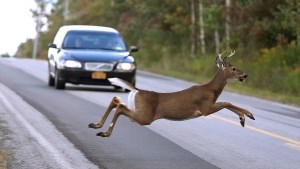The number of vehicular collisions with wildlife has spiked sharply upward compared to last year, and this has the Saskatchewan Wildlife Federation (SWF) concerned.
As of August 31, 2016, the number of claims submitted for collisions with moose and deer have increased over last year by more than 1,100. The largest increase by far is with deer at 1,096 more claims. SGI has paid out $35,282,575 in damages for both species already, and the worst three months of the year are yet to come.
“Harsh winter conditions are hard on our wildlife population,” said SWF executive director Darrell Crabbe. “Yet with recent milder conditions, we are seeing our wildlife population numbers rebounding. Combine that with the increased traffic on our provincial roadways, and there are bound to be increased chances of collisions.”
Once again, the Saskatchewan Wildlife Federation (SWF) with financial support from SGI, is engaging in a public safety campaign to encourage drivers to be more aware of wildlife, especially moose and deer, crossing the roads.
The public safety campaign is titled Moose on the Loose and is very similar to previous years. Reminders to slow down during peak wildlife movement times and to generally be more aware of the potential of an animal dashing out in front of their vehicle will be the messaging used on highway billboards, in radio and TV public service announcements, on posters and restaurant placemats at SWF dinner functions.
More vehicular collisions with wildlife typically happen in the months of October, November and December than in other months. This is due to the breeding season or ‘rut’ taking place and moose and deer are much more mobile during these months.
“While a vehicular collision with a deer can be very costly and sometimes cause personal injury, a collision with a moose can have very dire consequences” said Crabbe. “That’s why we engage in this annual campaign. It is our hope that the message will save lives, both human and wildlife.”



